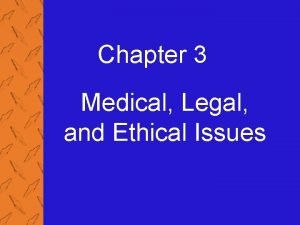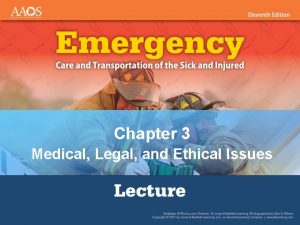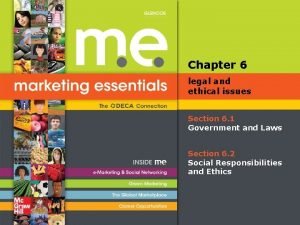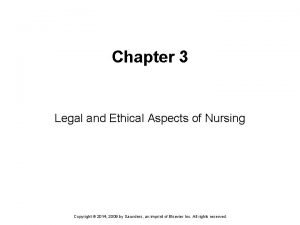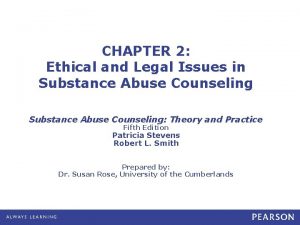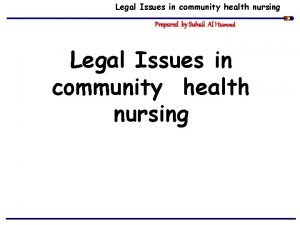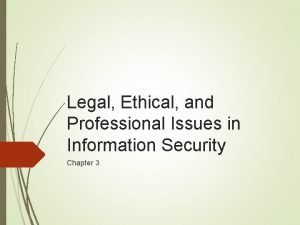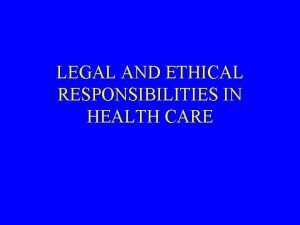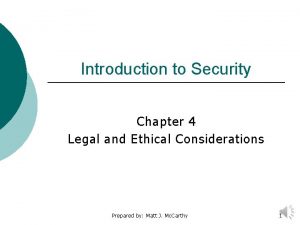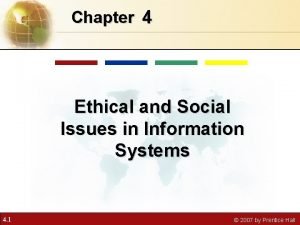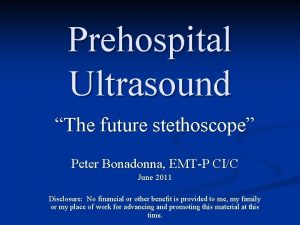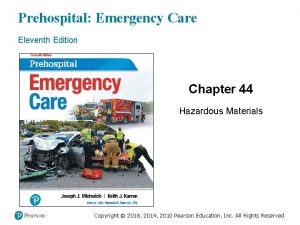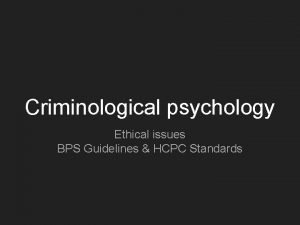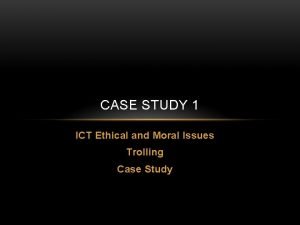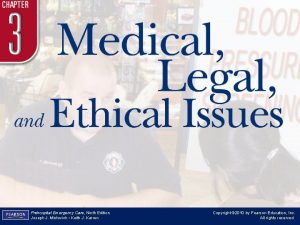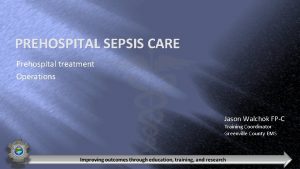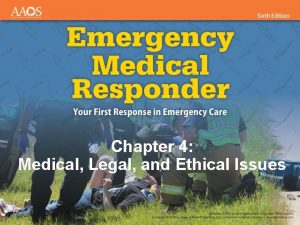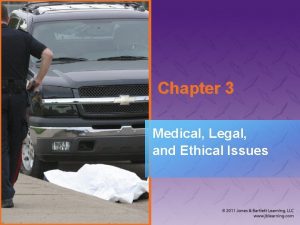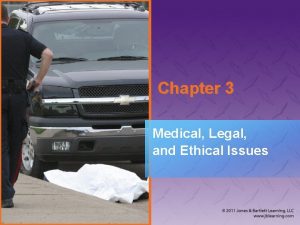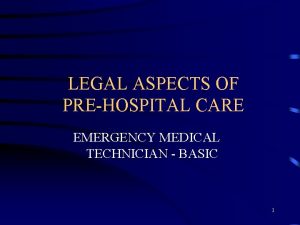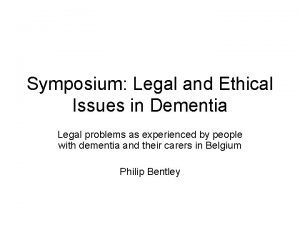Chapter 3 Medical Legal and Ethical Issues Prehospital






















































































- Slides: 86

Chapter 3 Medical, Legal, and Ethical Issues Prehospital Emergency Care, Ninth Edition Joseph J. Mistovich • Keith J. Karren Copyright © 2010 by Pearson Education, Inc. All rights reserved.

Objectives 1. 2. 3. 4. 5. Define key terms introduced in this chapter. Differentiate between the concepts of scope of practice and standard of care (slides 14 -16) Given a scenario, determine whether you would have a duty to act (slides 17 -18). Explain your duties with respect to patients, your partner, yourself, and your equipment (slide 18). Describe the intent of Good Samaritan laws (slides 19 -20).

Objectives 6. Explain each of the following legal protections for EMTs (slides 21 -22): a. Sovereign immunity b. Statutes of limitations c. Contributory negligence of the patient 7. 8. 9. Explain the EMT’s legal obligations with respect to medical direction (slides 23 -24). Differentiate between the concepts of ethics and morals (slide 25). Describe the ethical responsibilities of EMTs (slides 25 -26).

Objectives 10. Given a scenario presenting an ethical dilemma, discuss the consequences of various decisions and actions (slides 25 -26). 11. Explain each of the following types of consent (slides 27 -29). a. b. c. d. e. Informed consent Expressed consent Implied consent Consent to treat minors Involuntary consent

Objectives 12. Compare and contrast the typical provisions and prehospital applications of each of the following types of advance directives (slides 30 -32): a. b. c. d. Do not resuscitate order Living will Durable power of attorney Physican orders for life-sustaining treatment 13. Given a scenario in which a patient has an advance directive, determine the appropriate action to be taken (slides 30 -32). 14. Given a scenario in which a patient refuses care, discuss the actions you should take (slides 33 -36). 15. Differentiate between criminal and civil liability (slide 39).

Objectives 16. Explain the concept of negligence (slides 37 -48). 17. Give examples of ways you can avoid each of the following tort claims (slides 49 -58): a. b. c. d. e. Abandonment Assault Battery False imprisonment/kidnapping Defamation 18. Explain patients’ rights and your legal and ethical responsibilities concerning confidentiality and privacy (slides 59 -62). 19. Describe COBRA and EMTALA provisions as they apply to EMS (slides 63 -64).

Objectives 20. Give examples of ways you can protect yourself legally in transport and transfer situations (slides 65 -66). 21. Describe special considerations for patients who are potential organ donors (slides 67 -68). 22. Identify presumptive signs of death (slides 71 -73). 23. Identify situations in which law enforcement or the medical examiner’s/coroner’s office should be contacted.

Objectives 24. Discuss special considerations in responding to potential crime scenes (slides 74 -75). 25. Describe situations in which the EMT may be mandated to make a report, such as suspected abuse, crimes, and infectious diseases (slides 76 -77).

Topics The Scope of Practice Issues of Patient Consent and Refusal Other Legal Aspects of Emergency Care

CASE STUDY Dispatch

EMS Unit 105 Proceed to 733 East Third Street for an elderly male with abdominal pain. Time out 1430

Upon Arrival • You find an elderly female at the door • The house is so cluttered you can barely pass through • Male lying on bed moaning; undergarments stained • Room is very cold

How would you proceed?

The Scope of Practice Back to Topics

Legal Duties Back to Objectives

• Scope of practice • Standard of care (© Craig Jackson/In the Dark Photography)

Legal Duties Duty to Act Back to Objectives

• • • Duty to act Duty to patient Duty to self Duty to your partner Duty for your equipment Back to Objectives (© Sun Herald/Corbis)

Legal Duties Good Samaritan Laws Back to Objectives

• Enacted in 1959 in California • For unpaid services • Does not prevent you from being sued (© Mark C. Ide)

Legal Duties Other Legal Protections Back to Objectives

• Sovereign immunity • Statute of limitations • Contributory negligence

Legal Duties Medical Direction Back to Objectives

• Follow standing orders as approved by medical direction • Establish communication with medical direction as needed

Ethical Responsibilities Back to Objectives

• Ethics • Morals • Code of ethics Back to Objectives

Issues of Patient Consent and Refusal Back to Topics

Types of Consent Back to Objectives

• Informed consent • Expressed consent • Implied consent • Consent to treat a minor • Involuntary consent

Advance Directives Back to Objectives

• • Do not resuscitate order (DNR) Living will Durable power of attorney Physician order for life-sustaining treatment (POLST)

• Know your state’s laws and protocols • DNR must be present • Make sure it is valid • If there any questions, start resuscitation

Refusing Treatment Competency Back to Objectives

• Patient must be lucid and capable of making an informed decision • You must make patient fully aware of the consequences

Refusing Treatment Protecting Yourself In Refusal Situations

• • • Try again to persuade the patient Make sure the patient is competent Any questions, contact medical direction Encourage the patient to seek help later Document, document

Other Legal Aspects of Emergency Care Back to Topics

Negligence Back to Objectives

• • Criminal Civil Tort Negligence Back to Objectives

Four Elements to Prove • • The EMT had a duty to act The EMT breached that duty to act The patient suffered injury or harm The injuries were the result of the breach of the duty

Negligence Duty to Act

Obligation to respond to the scene and provide emergency care to patient

Negligence Breach of Duty to Act

• Negligence • Simple negligence • Gross negligence

Negligence Damages

Damages refers to injuries that are real, demonstrable, and recognizable by the law. (© David Handschuh)

Negligence Proximate Cause

Injuries a direct result of EMT negligence

Intentional Tort Back to Objectives

Action knowingly committed by an individual that is considered to be civilly wrong according to the law

Intentional Tort Abandonment

Stopping treatment without transferring care to another professional of equal or higher training

Intentional Tort Assault and Battery

• Assault • Battery

Intentional Tort False Imprisonment or Kidnapping

Transporting a competent patient without his consent

Intentional Tort Defamation

• Defamation • Slander • Libel

Confidentiality Back to Objectives

• Know your jurisdiction's laws • Release information only in specific cases

Health Insurance Portability and Accountability Act (HIPAA)

Federal law that protects the privacy of patient health care information

COBRA and EMTALA Back to Objectives

• Consolidated Omnibus Budget Reconciliation Act (COBRA) • Emergency Medical Treatment and Active Labor Act (EMTALA)

Protecting Yourself in Transport and Transfer Situations Back to Objectives

(©Maria A. H. Lyle) • Get a full report about the patient’s condition • Ensure you can provide appropriate level of care • Obtain signed informed consent form • Obtain written certification of transfer from physician • Know where you are going; take the quickest possible route

Special Situations Donors and Organ Harvesting Back to Objectives

• Identify patient as potential donor • Relay information to hospital • Provide emergency care

Special Situations Medical Identification Insignia

• Look for tags identifying medical conditions • Look on wrist, around neck, or on a card

Special Situations Recognizing Death in the Field Back to Objectives

• No pulse, breathing, or breath sounds • Complete unresponsiveness • No pupil response • Absence of a blood pressure • No reflexes Presumptive Signs of Death

Obvious Signs • • Decapitation Rigor mortis Decomposition Dependent lividity

Special Situations Crime Scenes Back to Objectives

• Observe and document the unusual • Do not cut through holes from bullet or stab wounds • Scene safety • Take one way in and out • Touch only what you have to • Tell police if you move or touch anything (© Craig Jackson/In the Dark Photography)

Special Situations Special Reporting Situations Back to Objectives

• Abuse • Crime • Drug-related injuries (© Robert A. Felter, M. D. )

CASE STUDY Follow-Up

CASE STUDY Assessment • S: conscious but disoriented; complains of abdominal pain; no signs of acute distress • AMPLE: unable to obtain from patient or wife

CASE STUDY Assessment • Wife appears not to understand situation • No change in condition during transport

CASE STUDY An Ethical Obligation • After transfer to hospital personnel, you contact social services; believe it is elderly neglect • Two weeks later you are told patient was diagnosed with a gastric ulcer and organic brain syndrome

CASE STUDY An Ethical Obligation • Mrs. Schuman, wife, diagnosed with Alzheimer’s disease • Both are now residents of extended -care nursing home

Critical Thinking Scenario • 34 -year-old female patient complaining of abdominal pain • Upon arrival, you find the patient lying in bed • She is alert and holding her abdomen • She states that she is having bad “belly pain” • Pain began about an hour ago

Critical Thinking Scenario • You perform an assessment, place the patient on oxygen, and prepare for transport • The patient suddenly states, “I don’t want to go to the hospital”

Critical Thinking Questions 1. How would you initially gain consent from this patient? 2. How would you manage the patient’s refusal to be transported? 3. What legal issues may you face if you continue with treatment and transport?

Reinforce and Review Please visit www. bradybooks. com and follow the my. Bradykit links to access content for the text.
 Medical legal and ethical issues chapter 3
Medical legal and ethical issues chapter 3 Legal and ethical issues chapter 3
Legal and ethical issues chapter 3 Medical legal and ethical issues chapter 3
Medical legal and ethical issues chapter 3 Chapter 2 ethical and legal issues
Chapter 2 ethical and legal issues Legal and ethical issues chapter 3
Legal and ethical issues chapter 3 Legal and ethical issues chapter 5
Legal and ethical issues chapter 5 Chapter 6 legal and ethical issues
Chapter 6 legal and ethical issues Legal and ethical issues chapter 5
Legal and ethical issues chapter 5 Legal and ethical aspects of nursing
Legal and ethical aspects of nursing Chapter 2 ethical and legal issues
Chapter 2 ethical and legal issues Ethical and legal issues chapter 2
Ethical and legal issues chapter 2 Chapter 5 legal and ethical issues
Chapter 5 legal and ethical issues Legal and ethical issues chapter 5
Legal and ethical issues chapter 5 Chapter 2 ethical and legal issues
Chapter 2 ethical and legal issues Chapter 6 legal and ethical issues
Chapter 6 legal and ethical issues Chapter 6 legal and ethical issues
Chapter 6 legal and ethical issues Resourceful citer
Resourceful citer Professional issues ethics and computer law
Professional issues ethics and computer law Legal and ethical issues in use of ict in education
Legal and ethical issues in use of ict in education Ecommerce legal issues
Ecommerce legal issues Legal and ethical issues in computer security
Legal and ethical issues in computer security Professional and ethical issues during internship
Professional and ethical issues during internship Ethical issues in computer security
Ethical issues in computer security Ethical and legal issues affecting the nursing assistant
Ethical and legal issues affecting the nursing assistant What is the difference between ethical and legal issues
What is the difference between ethical and legal issues Legal aspects of community health
Legal aspects of community health Legal and ethical issues in information security
Legal and ethical issues in information security Ethical and legal issues in psychiatric nursing
Ethical and legal issues in psychiatric nursing Prehospital emergency care 11th edition chapter 1
Prehospital emergency care 11th edition chapter 1 Dho chapter 5 legal and ethical responsibilities
Dho chapter 5 legal and ethical responsibilities Legal responsibility in healthcare
Legal responsibility in healthcare Chapter 4 legal and ethical responsibilities
Chapter 4 legal and ethical responsibilities Nonmaleficence
Nonmaleficence Chapter 4 ethical and social issues in information systems
Chapter 4 ethical and social issues in information systems 4 components of an information system
4 components of an information system Ethical issues in qualitative research chapter 4
Ethical issues in qualitative research chapter 4 Chapter 4 ethical issues
Chapter 4 ethical issues Chapter 4 ethical issues
Chapter 4 ethical issues Ethical decision making and ethical leadership
Ethical decision making and ethical leadership Prehospital emergency care 10th edition
Prehospital emergency care 10th edition Pre-hospital communication
Pre-hospital communication Cincinnati prehospital stroke scale
Cincinnati prehospital stroke scale Lams stroke scale
Lams stroke scale Prehospital emergency care 11th edition study guide
Prehospital emergency care 11th edition study guide Prehospital emergency care 11th edition
Prehospital emergency care 11th edition Cincinnati prehospital stroke scale
Cincinnati prehospital stroke scale Best prehospital stethoscope
Best prehospital stethoscope Prehospital emergency care 11th edition
Prehospital emergency care 11th edition Legal and ethical responsibilities of a coach
Legal and ethical responsibilities of a coach What ishipaa
What ishipaa The legal and ethical environment of business
The legal and ethical environment of business Ethical and legal frameworks in nursing
Ethical and legal frameworks in nursing Social and ethical issues itgs
Social and ethical issues itgs Accounting ethical issues
Accounting ethical issues Ethical and social issues in information systems doc
Ethical and social issues in information systems doc Ethical and social issues in information system
Ethical and social issues in information system How ethical social and political issues are connected
How ethical social and political issues are connected Ethical social and political issues in e-commerce
Ethical social and political issues in e-commerce Itgs social and ethical issues
Itgs social and ethical issues Ethical and social issues in information systems
Ethical and social issues in information systems Reward system and legal issues
Reward system and legal issues Legal regulatory and political issues
Legal regulatory and political issues Perbedaan ethical dilemma dan ethical lapse
Perbedaan ethical dilemma dan ethical lapse Ethical lenses army
Ethical lenses army Perbedaan ethical dilemma dan ethical lapse
Perbedaan ethical dilemma dan ethical lapse Ethical issues in entertainment
Ethical issues in entertainment Ethical issues in accounting
Ethical issues in accounting Ethical considerations in experimental research
Ethical considerations in experimental research Ethical issues in group therapy
Ethical issues in group therapy Nike accused of tolerating sweatshops
Nike accused of tolerating sweatshops International business ethics definition
International business ethics definition Ethical issues in treating lgbt patients
Ethical issues in treating lgbt patients Ethical issues in coaching
Ethical issues in coaching Ethical issues definition
Ethical issues definition Ethical issues in e marketing
Ethical issues in e marketing Bps ethical issues
Bps ethical issues Ethical issues in applied behavior analysis
Ethical issues in applied behavior analysis Volkswagen ethical dilemma
Volkswagen ethical dilemma Ethical issues in career counseling
Ethical issues in career counseling Ict ethical issues
Ict ethical issues Ethical issues of genetic engineering
Ethical issues of genetic engineering Ethical issues in precision medicine
Ethical issues in precision medicine Nike international business
Nike international business Define cyber crime
Define cyber crime Facebook ethical issues case study
Facebook ethical issues case study Objectives in immersion
Objectives in immersion Ethical issues in research
Ethical issues in research
